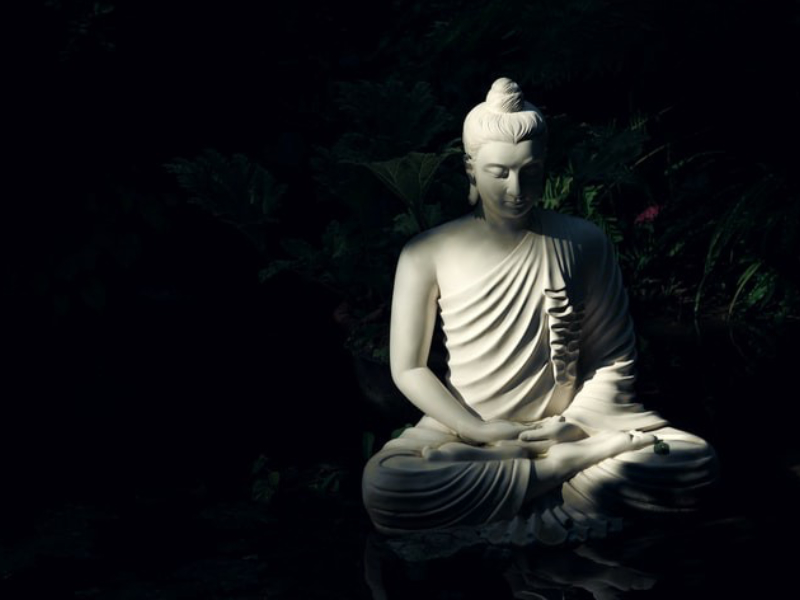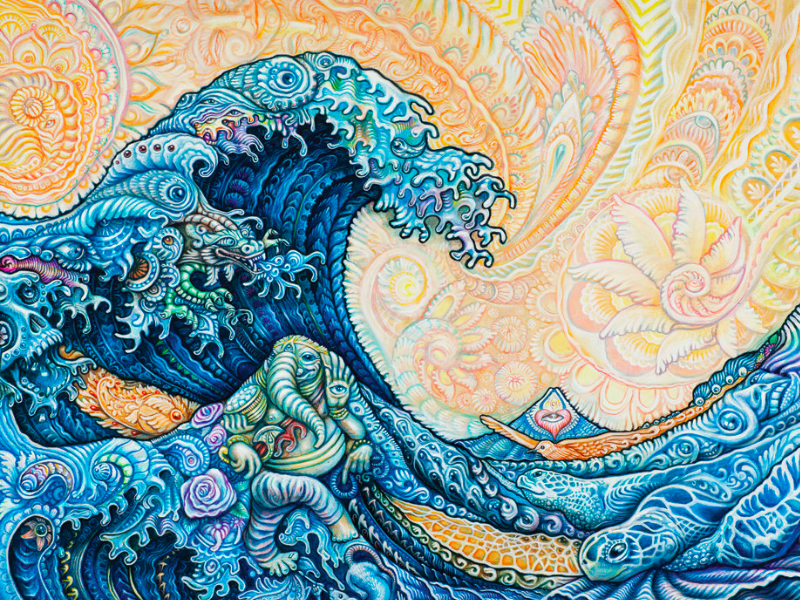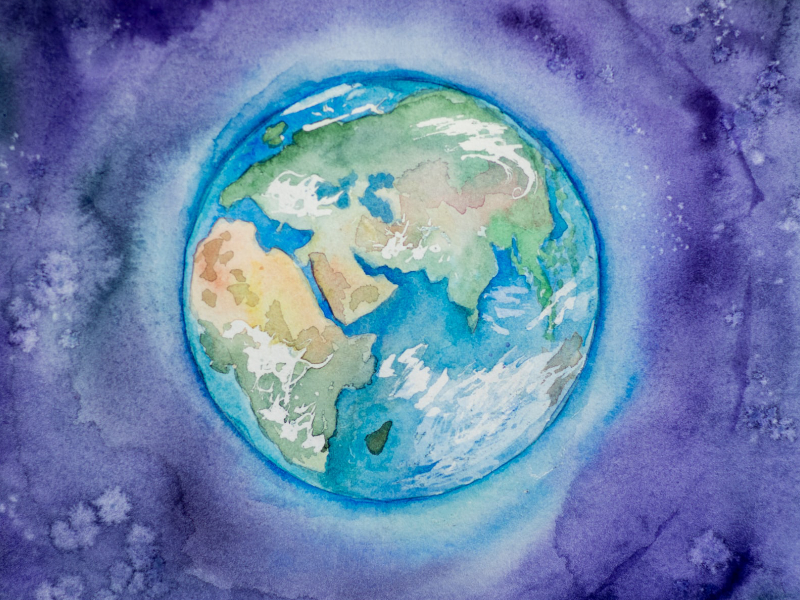Mindfulness & Insight
– The Noble Eightfold Path | Mindfulness –

The ultimate truth — God, Nature, Love, Awareness, or whatever you wanna call it — is directly available, patiently waiting to be witnessed and embodied. If you want to find it, turn inward and realize it within yourself. Know directly the truth of your own experience.
This is a truth you can’t be told. It’s a truth you can’t accept on faith. And it’s a truth you can’t work out intellectually or conceptually. You can only know it directly, as an immediate and intimate kind of knowing, a bare knowing.
That brings us to today’s topic — mindfulness. If you recall, last episode we began exploring the final arena of training in the Buddha’s Noble Eightfold Path, training in cognition, which cultivates and balances three faculties of mind: effort, mindfulness, and concentration. Last time, we covered only the first of these three, effort. Today, then, we’ll move onto mindfulness.
What is Mindfulness?
What is mindfulness? Well, let me first try to describe it succinctly so you get an idea of what I’m pointing at, and then we’ll flush it out more fully. So, mindfulness is an immediate, direct, and present knowing. One that can’t be carried into the future, remembered from the past, or written in a book. It can’t be contained in thought. It is a raw or bare awareness, though not a mindless awareness that accompanies all conscious experience, where the lights are simply on. In addition to the lights being on, or the contents of consciousness being illuminated, awareness itself is illuminated. There is an immediate and direct knowing of awareness itself. Finally, mindful awareness has no biases or prejudices, it has no preferences, no likes or dislikes. It doesn’t grasp at the pleasant or push the unpleasant away. It allows all things as they are, without reacting to them.
Okay, let’s flush this out.
First, I said mindfulness is a kind of knowing that is immediate, direct, and present. And you’ll often hear many people describe mindfulness as being present, as being in the now. But there is more to this than may meet the eye.
Some people believe we are always aware of the present. After all, where else could we be other than right here? And to some degree, these people would be right. All experience, even our memories and thoughts about the future, happen here in the present. This kind of presence, though, doesn’t quite capture the kind of presence that accompanies mindfulness.
With ordinary conscious states, there is a direct impression of experience from the present, but then our cognitive faculties quickly superimpose a conceptual framework around the direct impression, in an interpretative way. So, the mind receives the raw experience free from concepts only briefly before the original experience is clouded by layers of perception and ideas, like seeing the moon through a thick fog.
“The day you teach a child the name of a bird, the child will never see that bird again.” — Krishnamurti
The Buddha called this process papañca — elaboration, embellishment, or conceptual proliferation — which doesn’t allow us to see experience as it is, but only at a distance. It’s this process that is also the culprit of our projections. Deluded by ignorance, we throw our biases and prejudices onto experience, ascribing them to experience as if they really belonged to it. So, as Bhikkhu Anālayo says, what we use as the basis for our values, plans, and actions, is actually just a patchwork product, the embellishments fabricated by the mind, not the original thing.
To correct this distortion, we need wisdom. But for wisdom to do its work, it needs direct and immediate access to experience. It needs to be able to penetrate the clouds of papañca. This is the task of mindfulness, to bring to light the raw data of experience, to reveal the objects of awareness as they are before they have been stenciled and colored over by concepts.
When we practice mindfulness, then, we’re not so much doing something as we are undoing. It’s like when Jesus told us to learn to see again through the eyes of a child, so that we may enter the Kingdom of Heaven. When we practice, we don’t interfere with experience. We don’t try to manipulate it or dominate it or control it. We simply receive its raw data. We step into the foundational wonder of all things. In this way, by simply noting experience as it is, mindfulness undoes all the knots we’ve created by trying to assert our ‘selves’ into experience in some way.
This is what I mean when I say that mindfulness is an immediate, direct, and present kind of knowing. This, however, isn’t enough. Mindfulness requires more.
To demonstrate why presence isn’t enough, I’ll refer to Joseph Goldstein, who often uses the example of a black lab to demonstrate this point. Now, black labs, as you know, are incredibly present — they’re not lost in thought, they’re not planning their day or remembering some interaction from the past. No, they are right here, immersed in their sense of smell, interested in their surroundings, and happy to be with you. I don’t think there’s much conceptual proliferation going on, like you see in humans. But…is a black lab really that mindful? Probably not.
Okay, so what are they missing? Well, another aspect to mindfulness is what scientists call meta-awareness, an awareness of awareness. In all states of consciousness, even during REM sleep, experience is happening—the lights are on. But there is not always a meta-awareness, an awareness of the process of awareness itself. Just consider the times you found yourself opening the fridge for the third time?
In instances like this, experience is happening — the lights are on — but we aren’t really aware of awareness itself. We may be so lost in our TV show, for example, that we become absorbed in it. We got lost in the story. We forget that what we are really just seeing pixels of light on a screen. And, because we are not mindful as we watch, because we’ve collapsed into the story, we lose awareness of the tastes and textures of the food we’re putting in our mouth, to say nothing of our intention to keep putting food in our mouth. The objects of awareness are present, but the meta-awareness is not.
The truth is, we are more like black labs than we’d like to admit. Most of us most of the time really aren’t aware of this knowing aspect. We too easily become identified with the objects that arise in awareness — our thoughts, feelings, moods, and emotions. We take them to be who we are. And then these thoughts, feelings, moods, and emotions end up dragging us around and, sometimes, even say and do stupid shit.
As your practice deepens, though, you will increasingly become aware of the awareness side of the coin. You will see that from the wide open and formless space of the mind, everything arises in a pairwise progression of knowing and object. There are bodily sensations and the knowing of these bodily sensations, feelings and the knowing of feelings, sounds and the knowing of sounds, thoughts and the knowing of thoughts. You will discover that everything is simply arising and being known all on its own and in its own place.
Okay, so in addition to being present, mindfulness also requires this meta-awareness, an awareness of awareness, knowing that we’re knowing.
Is there anything else? Yes. And though we already touched on it a bit, because it is such a crucial aspect of mindfulness, the real key to freedom, let me just spell it out a bit more. This aspect of mindfulness is what we can think of as the all-encompassing embrace of mindfulness, an awareness that allows space for everything to arise and disappear all on its own and in its own time. It is this dimension that holds everything, every experience, every sensation, feeling, thought, and emotion, whether pleasant or unpleasant, with complete equanimity or composure, without reacting to it, without grasping at the pleasant or pushing the unpleasant away. It has no biases, preferences, or prejudices.
To be clear, this is not the same thing as being indifferent to experience. Indifference is the near enemy of this quality of mindfulness. Rather than numbing out or becoming indifferent to our experience, this loving or equanimous aspect of mindfulness is receptive to experience. It asks us to really be with, to touch, whatever is arising, whether it’s pain, grief, sorrow, anger, frustration, fear, worry, anxiety, stress, desire, hatred, compassion, joy, or whatever. We connect with the emotion fully, without reacting to it. We hold it like a newborn baby, eager to love and understand it, shining the light of mindfulness on it as long as it needs before it fades back into the open empty space of awareness all on its own.
As you pay more and more attention to the mind itself through practice, I think you’ll see that this is the nature of awareness itself. Awareness holds every aspect of experience without preferences. It is that which simply knows. All desires or aversions, all likes and dislikes, all that can be known, arises and fades away in awareness. And whatever arises and fades away in awareness is not and cannot be what awareness is. So again, to be mindful, you must step into that formless open space of awareness, you must occupy it and embody it. Rather than collapse into its objects, you must become that which simply knows, that which is entirely open and receptive to the fullness of existence, that which is already perfectly still and at peace.
Okay, hopefully that gives you an idea of what it means to be mindful. And if you are still a bit unsure, no worries, your understanding will unfold in time with practice. Now that we have some idea, though, let’s go ahead and see how mindfulness fits into the greater context of the Buddha’s Noble Eightfold Path.
Mindfulness & the Noble Eightfold Path
In the context of the Noble Eightfold Path, we cultivate mindfulness not as an end in itself but as a means to insight and understanding, which ties us back to the first arena of training, training in wisdom. We want to use our insights and understanding to discern with wisdom what keeps us on the path of peace and freedom and what leads to more suffering, dis-ease, and dissatisfaction.
To do this, the Buddha created a useful framework that invites us to establish mindfulness in four arenas of experience, called the Four Foundations of Mindfulness, which he says provide a direct path to awakening. These four foundations are:
- The body
- Feelings
- Mind-states and emotions
- Dhammas; or the laws, processes, and ultimate nature of reality, as well as the various mental faculties
“Here, one contemplates the body in the body…feelings in the feelings…the mind in the mind…mental frameworks in mental frameworks, ardent, mindful, and clearly comprehending each of them, having overcome desire and ill-will” — The Buddha
As you can see in this quote, to gain insight and understanding and develop wisdom, the Buddha is telling us we need more than mindfulness alone.
We need fuel and support from ardor or effort, some interest and passion. And we need the intellect, we need to clearly comprehend what we’re doing and why.
This means we need to comprehend the frameworks that propel us, our views, beliefs, and understanding. We need to see clearly the maps that navigate us through this mysterious floating world, like the Noble Eightfold Path, and comprehend which lens we are using to look at everything. Are we seeing through the lens of mindfulness or are we seeing and relating to everything through the ego, through desire, hatred, or delusion?
Some other subtle views or lenses we often find ourselves in are what I like to call the ‘shopping lens’ and the ‘comparing lens.’ With the shopping lens, we view the world in terms of what we ‘want’ or ‘don’t want,’ like when we’re browsing through a store. And with the comparing lens, we look at everything as if everything is in a contest against everything else. We do this all the time when we claim favorites, and even force people into this comparing frame when we ask them what their favorite x, y, or z is, or which thing they like better. I can’t tell you how many people ask my kids these kinds of questions — what’s your favorite. There’s no blame here, it’s just that these are the kinds of questions we’ve been conditioned to ask kids or other people we’re trying to get to know. There is also the ‘Tinder lens,’ which looks at everything in terms of being attractive or not.
Mindfulness and clear comprehension require us to become aware of these subtle frames. In the history of western science, or epistemology, this was very hard to understand even among some of the greatest thinkers. Since Locke and Hume, the tabula rasa, or ‘blank slate’ theory, has dominated much of scientific thinking. Though there were some like Charles Darwin who said, “How odd it is that anyone should not see that all observation must be for or against some view,” science didn’t really understand that we have to view everything from a certain frame until the humble giant Karl Popper established an open cyclical epistemology of conjecture and refutation. On the first day of class, Popper would ask his students simply to observe. And after a long awkward silence, finally a student would muster up the courage to ask, “Um, professor, what exactly is it that we’re supposed to observe.” “Ah ha!” he would reply, “exactly the point!”
It’s funny, as I went to bed last night, after working on this episode, I turned on a movie. And when I watch movies, I like to be aware of the screenplay. And one of the first things I like to notice, by my own inference and not by looking it up, is whether the script was written by a man or woman. In this movie I watched, it was way too obvious that the screenplay was written by a man. I like it when I honestly can’t tell whether a man or woman wrote it. But anyway, I tell this story because this, again, is another example of the subtle frames we use to look at the world. How mindful are you of your frames? Are you clearly comprehending your aim and whether these frames serve that aim?
This is another crucial point. We need to clearly comprehend our aim, and also see whether our words, actions, and omissions, achieve that aim skillfully and efficiently. So, really, clear comprehension brings the relative side of the coin into sharp view, which allows humans to do what they do best: manipulate conditions to achieve a desired outcome, which in our case is wisdom, or liberation.
So, again, mindfulness is not an end in itself. It is a means to wisdom. And wisdom is not possible without first being able to meet experience directly, with a loving and welcoming embrace, with composure and equanimity, with an interest to see and understand it as it is.
So, start taking a look. Examine the body with effort, mindfulness, and clear comprehension. How do you know you have a body? What is it as a matter of direct experience? Where do you know the body? What is it the experience of the body like? Is it stable and unchanging? How is your body showing up in and navigating through the world? How is it supporting your aims?
Examine with effort, mindfulness, and clear comprehension the pleasant, unpleasant, and neutral feelings tones. How do you know you have feelings? What are they as a matter of direct experience? Where are they? What are they like? Are they stable and unchanging? Do they condition your automatic reactions to the world? When you feel something pleasant, are you pulled toward it? Do you end up doing shit you regret almost immediately? When you feel something unpleasant, do you retreat? Do you whine and pout? Do you get angry or frustrated? Do you get worried or scared? When you feel something neutral, do you space out?
Examine with effort, mindfulness, and clear comprehension the different mind-states and emotions that color awareness. What’s attitude or posture is the mind taking? Is there desire, greed, or lust in the mind? Where is it? What is that like? Is there aversion, anger, hatred, disgust, or ill-will in the mind? Where is it? What is it like? Is there delusion or confusion in the mind? Where is it? What is it like? Are these mind-states who or what you take yourself to be? Are they stable and unchanging?
Examine with effort, mindfulness, and clear comprehension the mind itself. How do you know you have a mind? Where is it? What is it? What is it like? Is it formless, open, and free? Does it have the quality of connection, warmth, love, and compassion? Does it feel spacious, awake, and alert? Is it already entirely at peace?
Conclusion
Well, I think that’s enough for today.
In a future episode, we will explore in more depth the satipatthana sutta, which spells out this direct path to awakening. And when we do this, I will cover in more detail the fourth foundation, the establishment of dhammas: the laws, processes, and ultimate nature of reality, as well as the various faculties of mind. This includes the five hindrances, which cloud the mind and prevent us from recognizing our innate peace and freedom. It includes the seven factors of awakening: mindfulness, investigation, energy, joy, tranquility, concentration, and equanimity, all of which work together to rid the mind of the hindrances and defilements. And it includes the five aggregates, the six sense bases, and the Four Noble Truths, which are frameworks to help describe the ultimate nature of reality and being.
In any case, thanks for putting in the work. You really are a remarkable creature. May you stay energized, mindful, and sharp today.
Until next time,
More Articles
“The Art of Bare Attention”
Today we’re going to talk about the ancient Buddhist practice vipassana, or insight meditation. Now, just to be clear, this is an entirely secular practice. It doesn’t require you to adopt any dogmatic beliefs…
“The Faceless Seer”
How do you hold your love? Do you hold her from stillness, with nowhere to go, with nothing to do? How do you hold your love? Do you hold her with acceptance, with open hands and arms, with unabashed…
“Everything Changes”
It’s no secret everything changes. Your experience this morning isn’t your experience now. Yet how many of us act like we really understand this? How often do we grasp onto the illusion of things…
“The Divine Connection”
How do you hold your love? Do you hold her from stillness, with nowhere to go, with nothing to do? How do you hold your love? Do you hold her with acceptance, with open hands and arms, with unabashed…






